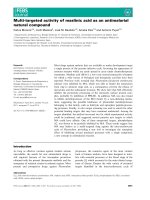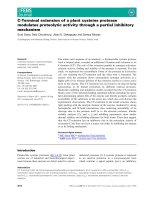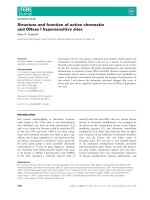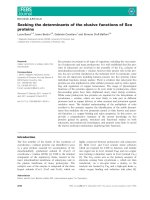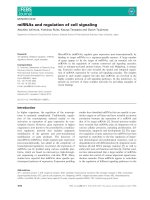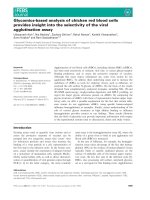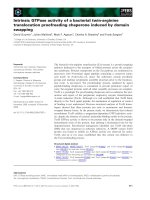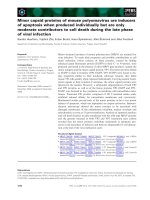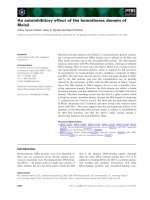Báo cáo khoa học: Sub-zero temperature inactivation of carboxypeptidase Y under high hydrostatic pressure pot
Bạn đang xem bản rút gọn của tài liệu. Xem và tải ngay bản đầy đủ của tài liệu tại đây (412.04 KB, 9 trang )
Sub-zero temperature inactivation of carboxypeptidase Y under high
hydrostatic pressure
Toshihiko Kinsho
1,
*, Hiroshi Ueno
1,
†, Rikimaru Hayashi
1
, Chieko Hashizume
2
and
Kunio Kimura
2,
†
1
Division of Applied Life Sciences, Graduate School of Agriculture, Kyoto University, Sakyo, Japan;
2
Meidi-Ya Food Factory Co.,
Ibaraki, Osaka, Japan
High hydrostatic pressure induced cold inactivation of
carboxypeptidase Y. Carboxypeptidase Y was fully active
when exposed to subzero temperature at 0.1 MPa; however,
the enzyme became inactive when high hydrostatic pressure
and subzero temperature were both applied. When the
enzyme was treated at pressures higher than 300 MPa and
temperatures lower than )5 °C, it underwent an irreversible
inactivation in which nearly 50% of the a-helical structure
was lost as judged by circular dichroism spectral analysis.
When the applied pressure was limited to below 200 MPa,
the cold inactivation process appeared to be reversible. In
the presence of reducing agent, this reversible phenomenon,
observed at below 200 MPa, diminished to give an inactive
enzyme; the agent reduces some of disulfide bridge(s) in an
area of the structure that is newly exposed area because of
the cold inactivation. Such an area is unavailable if carb-
oxypeptidase Y is in its native conformation. Because all the
disulfide bridges in carboxypeptidase Y locate near the act-
ive site cleft, it is suggested that the structural destruction, if
any, occurs preferentially in this disulfide rich area. A poss-
ible mechanism of pressure-dependent cold inactivation of
CPY is to destroy the a-helix rich region, which creates an
hydrophobic environment. This destruction is probably a
result of the reallocation of water molecules. Experiments
carried out in the presence of denaturing agents (SDS, urea,
GdnHCl), salts, glycerol, and sucrose led to a conclusion
consistent with the idea of water reallocation.
Keywords: high hydrostatic pressure; cold inactivation;
carboxypeptidase; serine protease; protein denaturation.
Carboxypeptidase isolated from Saccharomyces cerevisiae
(CPY) is an exopeptidase specific to C-terminal amino acid
residues of peptide or protein substrates. CPY is a
monomeric glycoprotein with 421 amino acid residues in
which four carbohydrate chains are attached via b amide
nitrogen of aspargine residues [1]. It has catalytically
essential serine, histidine and aspartate residues, which
make CPY as a member of serine protease family [2]. Like
other serine proteases, the enzyme also exhibits an esterase
activity. CPY maintains its activity in the presence of
relatively high concentration of SDS, glycerol or salts [3].
High hydrostatic pressure has been used as a denaturant
in study of protein structure. Accumulating evidence
suggests that pressure-dependent denaturation of protein
is a reversible process in most cases, where the process of
denaturation by high pressure appears to be significantly
different from that caused by pH, chemical agents or heat
[4,5]. Brandts [6], Hawley [7] and others have shown that a
combination of pressure and temperature is highly effective
method for the study of protein denaturation. Although
cold denaturation or inactivation of proteins is a recognized
subject matter in protein chemistry [8–11], combined effects
of cold temperature and high pressure on proteins have not
been explored extensively.
Cold denaturation (in general the terminology Ôcold
denaturationÕ is commonly used; however, we use Ôcold
inactivationÕ in this study because our emphasis is on the
inactivation of enzymic activity) of proteins has been shown
previously [12–16], where denaturation was due to subunit
dissociation, which is reversible, and sometimes due to
aggregation [17,18]. In the majority of the cold denaturation
experiments, the temperature employed was above freezing
point in order to avoid the problems associating with
sample being frozen. Most proteins, including monomeric
ones, are susceptible to freezing and readily become inactive.
Some attempts have been made to avoid sample freezing
by adding organic solvent [11]. Although the presence of
organic solvent was successful in lowering the freezing point,
down to )100 °C, some of the physical properties of protein
in such solution, i.e. thermal denaturation temperature and
kinetic data, were altered [8,9,11,19,20]. A protein whose
activity is preserved, despite prolonged treatment of subzero
temperatures in the absence of any antifreezing agent, might
be an ideal candidate for studying high pressure effects on
protein structure.
In the present study, high hydrostatic pressure and
subzero temperature are combined and used as denaturants
on CPY. It is also considered the effects of various agents,
including those commonly used for protein denaturation
and for protein stabilization at neutral pH.
Correspondence to R. Hayashi, Division of Applied Life Sciences,
Graduate School of Agriculture, Kyoto University, Sakyo, Kyoto
606-8502, Japan.
Fax: + 81 75 753 6128, Tel.: + 81 75 753 6110.
Abbreviations:ATEE,N-acetyl-
L
-tyrosine ethyl ester monohydrate;
BTEE, benzoyl-
L
-tyrosine ethyl ester; CPY, carboxypeptidase Y;
GdnHCl, guanidine hydrochloride.
*Present address: Sanyo Chemical Co., Kyoto, Japan.
Present address: Laboratory of Applied Microbiology and
Biochemistry, Nara Women’s University, Nara 630-8506, Japan.
(Received 19 March 2002, revised 29 June 2002,
accepted 5 August 2002)
Eur. J. Biochem. 269, 4666–4674 (2002) Ó FEBS 2002 doi:10.1046/j.1432-1033.2002.03167.x
MATERIALS AND METHODS
Reagents
Nicotinamide adenine dinucleotide (NADH) and sodium
pyruvate were from Sigma Chemical Co. (St Louis, MO,
USA). Benzoyl-
L
-tyrosine ethyl ester (BTEE), N-acetyl-
L
-tyrosine ethyl ester monohydrate (ATEE) and kerosene
were from Nacalai Tesque Co. (Kyoto, Japan). CPY was
prepared according to Hayashi et al. [3] The other reagents
were highest reagent grade obtained locally.
Cold denaturation of CPY under high hydrostatic
pressure
Pressurization apparatus was obtained from Hikari
Kohatsu Instruments Co. (model no. KP-5B, Hiroshima,
Japan) which generates maximum pressure of 600 MPa.
Approximately 200 lL of CPY solution (1–2 mgÆmL
)1
in
10 m
M
sodium phosphate buffer, pH 7.0) was placed in
polyethylene pouch and heat-sealed. This pouch was
placed in another polyethylene pouch, and distilled water
was used to fill between the two pouches. It was
imperative to eliminate any air bubbles from both plastic
bags. The double bag was placed inside of the pressure
vessel that was filled with kerosene and pre-equilibrated at
desired temperature. The pressure vessel was immersed
into a large refrigerated constant temperature water bath.
After the kerosene temperature reached equilibrium,
pressure was applied for 30 min. As a control, another
sample was kept at room temperature without pressuri-
zation. CPY activity was measured immediately after the
pressure release (ex situ).
CPY activity measurements
Enzymic activity was measured spectrophotometrically on a
Shimadzu UV-210A digital double beam spectrophoto-
meter. Both sample and reference cuvettes containing 2 mL
of 50 m
M
sodium phosphate buffer, pH 7.5 with and
without 1 m
M
ATEE, respectively, were placed in cell
holders. Sample temperature was maintained at 25 °Cwith
a constant temperature water bath. As soon as 10 lLofthe
aliquots of pressure-treated CPY was added into the sample
cuvette, a time-dependent linear absorbance change at
237 nm was recorded for 10–15 min. The slope of absorb-
ance change under 0.1 MPa was used for 100% activity and
that in the absence of CPY was 0% activity.
Circular dichroism measurements
Measurements of CD spectra were performed on a JASCO
J-720W spectropolarimeter (JASCO Co., Tokyo, Japan). A
quartz cell with 1 mm light path length was used for the
native and pressure-treated CPY (2.7 l
M
in 0.02
M
potas-
sium phosphate buffer, pH 6.0).
Molecular modeling
X-ray crystallographic data of carboxypeptidase Y (1ysc)
was obtained from the Protein Data Bank (http://
www.pdb.bnl.gov). Molecular modeling was performed
on an IRIS Indigo2-EX Silicon Graphics workstation by
using
QUANTA
96 software (Molecular Simulations, Inc.,
California, USA).
RESULTS
CPY at subzero temperature
When CPY solution was exposed to temperature ranging
from 22 to )30 °Cat0.1MPa(s in Fig. 1), nearly full
activity was maintained throughout the temperature range
examined. This suggests that CPY is highly resistant against
cold.
Effect of high pressure on CPY at low temperature
When CPY was exposed to 400 MPa at 10 °C, its activity
was reduced 50% within 10 min. Further treatment did not
show any additional changes in the activity (s in Fig. 2).
This suggests that a part of CPY structure is altered by
Fig. 1. Effect of temperature on CPY inacti-
vation under various pressures. Enzymic activ-
ities of CPY, which was treated with
atmospheric pressure (0.1 MPa) (s),
100 MPa (d), 200 MPa (h), 300 MPa (j),
and 400 MPa (n)attheindicatedtempera-
tures for 30 min, were measured. Each data
point represents an average of three separate
measurements. Inset shows a water/ice phase
diagram.
Ó FEBS 2002 Cold inactivation of CPY under high pressure (Eur. J. Biochem. 269) 4667
high-pressure treatment, but the rest appears to be resistant
when the treatment was carried out at 10 °C.
The apparent inactivation of CPY was evident when the
enzyme was exposed to lower temperatures (0 and )10 °C)
and at 400 MPa (d and h in Fig. 2). The time course of
CPY inactivation at 0 °C appeared to be a biphasic, and at
)10 °C it became monophasic, indicating that the cold
inactivation at )10 °C underwent a two-phase transition
mechanism. Thus, it is clear that the cold inactivation of
CPY is either induced or accelerated when high hydrostatic
pressure is applied.
As summarized in Table 1, pressure treatment of CPY
was carried out under two different conditions to investigate
a possible effect of ice formation during the experiments.
In one condition, high pressure was applied after thermal
equilibrium at the desired temperature was achieved.
During this equilibrium period, ice could form at tempera-
tures below 10 °C. In the other condition, both pressuriza-
tion and depressurization steps were performed at room
temperature to avoid any ice formation. Because there were
no significant differences on the degree of enzymic inacti-
vation between the two conditions, the idea of ice formation
being a contributing factor for the cold inactivation of CPY
was eliminated.
Circular dichroism analysis of cold inactivated CPY
Far-ultraviolet CD spectra (190–250 nm range) of both the
native and cold inactivated CPY (treated under 400 MPa at
)5 °C for 30 min) are shown in Fig. 3. Native CPY exhibits
a typical a/b mixed-type CD spectrum as having a negative
peak within 210–220 nm. The CD spectrum of the cold
inactivated CPY showed reduction of peaks, the positive
one at 194 nm and the negative one at 210–220 nm. The
results indicate a significant alteration in its secondary
structure of the cold inactivated CPY. As we performed a
quantitative analysis of the secondary structure according to
the method of Yang et al. [21] an approximately 50% loss of
the helical structure was estimated.
Combined effects of low temperature and high
pressure on CPY
As Fig. 1 exhibits smooth transition curves for pressure
treatment at 0.1–400 MPa at a temperature ranging from 22
to )30 °C, the effect of freezing was excluded as the cause of
inactivation. Curves also indicate that the loss of enzymic
activity is a pressure-dependent phenomenon. It is evident
that pressure-dependent inactivation becomes the predomi-
nant event at the temperature below )10 °C.
Reversibility of low temperature inactivation of CPY
under high pressure
Time-dependent recovery of CPY activity was observed
after the release of pressure (Fig. 4). When CPY activity was
Fig. 2. Kinetics of the pressure inactivation of CPY at 400 MPa under
different temperatures. Enzymic activities of CPY at different time
points were measured while CPY was pressurized under 400 MPa at
10 °C(s), 0 °C(d), and )10 °C(h).
Fig. 3. Circular dichroism spectra of the native and pressure-treated
CPY. Native CPY spectrum is shown as a solid line and the pressure-
treated CPY is shown as a broken line. CPY was pressure-treated
under 400 MPa at )5 °C for 30 min.
Table 1. Effect of ice formation on the pressure- and temperature-
dependent CPY inactivation. In method 1, CPY activity was measured
immediately following the depressurization of the sample treated by
the pressure as described under methods, where the pressurization
process was initiated after the inside pressure vessel reached the desired
temperature. In method 2, the pressure vessel was pressurized at room
temperature before it was incubated at the indicated temperature for
60 min. Before the pressure release, the vessel was placed in the 25 °C
water bath for 10 min in order to prevent the icing during the
depressurization period.
Pressure
(MPa)
Temperature
(°C)
Activity (%)
Method 1 Method 2
200 25 90 93
10 90 88
07783
)10 67 73
)20 54 46
300 25 77 77
10 68 62
05754
)53548
–15 19 29
4668 T. Kinsho et al. (Eur. J. Biochem. 269) Ó FEBS 2002
measured immediately after the treatment at 10 °Candat
400 MPa for 30 min, it reduced to around 45%. On
standing at 4 °C, this sample showed a gradual activity
recovery over 50 min. This suggests that the process of
structural alteration occurred under 400 MPa at 10 °Cis
reversible. On the other hand, when CPY was treated at 0 or
)10 °C under 400 MPa, no significant activity recovery was
observed. The results indicate that low temperature treat-
ment of CPY under 400 MPa exhibits a cold inactivation of
the enzyme, in which an irreversible damage is evident.
Effect of 2-mercaptoethanol upon cold inactivation
of CPY under high pressure
Table 2 summarizes the effect of 2-mercaptoethanol on
CPY, which is exposed to high pressure at 22 °Cand
)22 °C in the presence or absence of 0.1
M
2-mercaptoeth-
anol for 30 min. At 22 °C, the effect of 2-mercaptoethanol
was insignificant in the pressure range we examined. At
)22 °C, near complete inactivation of CPY was observed
for 100 and 200 MPa treatments in the presence of
2-mercaptoethanol. The results indicated that disulfide
bond(s) became accessible to reducing agent at or above
100 MPa below subzero temperature.
Effects of denaturing agents upon cold inactivation of
CPY under high pressure
CPY maintains 80% of its activity after 1 h incubation with
6
M
urea, in neutral pH buffers, at 25 °C under atmospheric
pressure (A. Yamazaki, H. Ueno & R. Hayashi, unpub-
lished results). This suggests that CPY is a highly resistant
protein against urea denaturation. The cold inactivation of
CPY was observed readily when either urea or guanidine
HCl was present (Table 3). A concentration of 1
M
urea was
sufficient to achieve more than 70% inactivation at )10 °C
under 200 MPa for 30 min. Higher concentrations of urea
lead to nearly 90% inactivation under the identical condi-
tions. Guanidine HCl is a stronger denaturant than urea;
near complete inactivation is achieved at guanidine HCl
concentration of 1
M
or above.
Effect of SDS upon cold inactivation of CPY under high
pressure
CPY was incubated at )10 °C for 30 min under 400 MPa
in the presence of various concentrations of SDS (Fig. 5).
SDS concentration at 1 m
M
or less (< 0.03% w/w)
exhibited a maximum (30%) protection from the inactiva-
tion. This protective action of SDS disappeared at the
concentration higher than 2 m
M
. The amount of SDS used
in the experiments was less than SDS/PAGE analysis.
Table 2. Effect of 2-mercaptoethanolrcaptoethanol upon CPY activity treated with high hydrostatic pressures at 22 and )22 °C. CPY activity was
measured immediately after the pressure treatment as described under methods, where the pressurization process was initiated after the inside
pressure vessel reached the desired temperature. Concentration of 2-mercaptoethanol was 0.1
M
.2ME,2-mercaptoethanol.
Temperature
(°C)
Pressure
(MPa)
Activity remaining (%)
% Loss of activity upon
addition of 2ME
)2ME +2ME
22 0.01 100 100 0
100 92 89 3.3
200 90 86 4.4
300 77 70 9.1
400 63 59 6.4
)22 0.01 94 90 4.3
100 78 4.5 94
200 56 3.9 93
Fig. 4. Change in CPY activity following the release of pressure.
Enzymic activities of CPY, which was exposed to 400 MPa pressure at
10 °Cfor60min(s), at 0 °Cfor90min(d), and at )10 °Cfor
30 min (h), were measured.
Table 3. Effect of urea and guanidine HCl on CPY inactivation at low
temperature. Experiments were performed at )10 °Cand200MPafor
30 min as described under methods.
Denaturant Concentration (
M
) Activity remaining (%)
Urea 0 79
127
221
311
Guanidine HCl 0 79
1 9.0
2 0.0
Ó FEBS 2002 Cold inactivation of CPY under high pressure (Eur. J. Biochem. 269) 4669
Effect of glycerol and sucrose upon cold inactivation
of CPY under high pressure
CPY was incubated at )10 °C for 30 min under 400 MPa
in the presence of either glycerol or sucrose. This condition
was chosen because both polyols showed a protective effect
against cold inactivation. The effects were linearly increased
up to 20% (about 2
M
) for glycerol and 1.0
M
for sucrose
(Fig. 6).
Effect of inorganic salt and cations upon cold
inactivation of CPY under high pressure
Sodium chloride acted in a manner similar to glycerol; its
protective effect increased linearly as the concentration was
raised up to 3
M
(Fig. 7).
Effects of monovalent cations were also examined, where
protective roles of monovalent cations were demonstrated.
Except for Li
+
ion, the examined cations, Cs
+
,Rb
+
,
NH
4
+
,K
+
,andNa
+
, fit into a linear line when CPY
activity was plotted against 1/ionic radii (Fig. 8). The results
indicate that smaller cationic ions have higher protective
effects than larger ions.
Structural summary of CPY
Fig. 9 represents a structural feature of CPY based upon
X-ray crystallographic data of Endrizzi et al. [22] where five
pairs of disulfide bonds and the catalytic triad, Ser146-
His397-Asp338, are colored in green. Peptide backbone was
also colored gradually according to the temperature factor.
Three principal features of CPY structure are shown: (a)
spatial orientation of a-helices; (b) location of disulfide
bridges; and (c) distribution of movable (flexible) residues.
Active site cleft of CPY is constructed with five a-helices,
these locate as if they surround the catalytic triad. In
addition, five disulfide bridges (Cys56–298, Cys198–207,
Cys217–240, Cys224–233 and Cys262–268) also locate close
to this active center. Three of them (Cys198–207, Cys217–
240, and Cys224–233, where the latter two are called
disulfide zipper) are on the a-helices. Cys56–298 locates at
very end of the short a-helix (300–313). Although the role of
the disulfide bridges in CPY is still undefined, they seem to
be important in maintaining the active structure because the
loss of disulfide bridge(s) results in the inactive enzyme [3].
Fig. 5. Effect of SDS on the pressure-induced inactivation of CPY under
the subzero temperature. Enzymic activities of CPY were measured
after the treatment of CPY with 400 MPa pressure at )10 °Cfor
30 min in the presence of indicated concentration of SDS.
Fig. 6. Protective action of glycerol and sucrose against pressure-
induced inactivation of carboxypeptidase Y under subzero temperature.
Enzymic activities of CPY, which was treated with 400 MPa pressure
at )10 °C for 30 min in the presence of indicated amount of glycerol
(d) or sucrose (s), were measured.
Fig. 7. Protective action of sodium chloride against pressure-induced
inactivation of carboxypeptidase Y under subzero temperature. Enzymic
activities of CPY were measured after it was treated with 400 MPa
pressure at )10 °C for 30 min in the presence of indicated amount of
NaCl (d).
4670 T. Kinsho et al. (Eur. J. Biochem. 269) Ó FEBS 2002
The red colored region in Fig. 9 represents highly flexible
area in CPY structure and is likely to be destroyed during
the heat denaturation. It is of interest to point out that the
central cleft rich in a-helix (colored blue) is a rather
immobile region. CPY is considered relatively stable enzyme
against various denaturants, i.e. chemical agents [23], pH
change [3], salts [24,25], and freezing [23]. The stability of
CPY may originate from the above-described three princi-
pal features.
DISCUSSION
Unique properties of CPY
CPY exhibits a typical pressure-dependent cold inactivation
phenomenon. When both subzero temperature and pressure
above 300 MPa are applied, the enzyme activity is strongly
inhibited. However, the enzyme remains fully active after
the exposure to subzero temperature under atmospheric
pressure. Other enzymes we have examined, like chymo-
trypsinogen A, pancreatic ribonuclease A, and lactate
dehydrogenase, showed a significant loss (10–20%) of
enzymic activity just by standing at subzero temperature for
30 min without extra pressure applied (T. Kinsho, H. Ueno
& R. Hayashi, unpublished results.) To this extent, CPY
has ideal properties for the study of the pressure-dependent
cold inactivation process. Previously, our own [26] and
other [27] studies have demonstrated the phenomenon of
pressure-induced cold inactivation of CPY. In this study,
detailed molecular events in the pressure-induced cold
inactivation of CPY are described.
Action of reducing agent which reveals site(s) of cold
inactivation
The action of reducing agent was drastic: only when two
denaturation elements, high pressure and subzero tempera-
ture, were combined, did the reducing agent successfully
inactivate the enzyme (Table 2). Because CPY is highly
resistant to reduction under native or pressurized conditions
at ambient temperature, the observed inactivation must
associate with some conformational changes occurring at
the sites near disulfide bond(s). Such conformational
changes enable the penetration of the reducing agent, as
well as solvents.
Figure 9 indicates the location of disulfide bonds in CPY.
It is apparent that both the disulfide bonds and a-helix rich
region locate at or near the central cleft as if they surround
the catalytic triad. Our present results with reducing
agent suggest that the structural alterations under the
Fig. 8. The correlation between the size of monovalent cationic ions and
their effects on activity of CPY treated under high pressure at subzero
temperature. Enzymic activities of CPY were measured after the
treatment with 400 MPa pressure at )10 °C for 30 min in the presence
of 1
M
of chloride salt of Li
+
(s), Na
+
(d), K
+
(h), Rb
+
(j), NH
4
+
(n), and Cs
+
(m). Dotted line indicates activity level for the absence of
salts.
Fig. 9. Spatial orientation of disulfide bonds
and temperature factor in computer generated
CPY model. CPY structure was visualized on
a SGI Indigo2-EX computer where location
of disulfide bonds is labeled. Temperature
factor listed in 1ysc PDB file was used for
coloring. Red is designated for 100 and blue
for 0.
Ó FEBS 2002 Cold inactivation of CPY under high pressure (Eur. J. Biochem. 269) 4671
pressure-dependent cold inactivation occurs in this a-helix
rich region.
Figure 9 also represents flexibility of CPY based upon
crystallographically determined temperature factor. It pro-
vides an important clue concerning the structural aspects of
the pressure-dependent cold inactivation. It is evident that
the above-mentioned a-helix rich region is found in the blue
colored area, suggesting that the a-helix rich region is less
inert towards heat but can be sensitive to the pressure-
dependent cold inactivation as described above in the study
with the reducing agent. It is also suggested that there are
separate denaturation pathways in CPY towards heat and
pressure-dependent cold inactivation (Scheme 1). A similar
conclusion was previously obtained by others in the study of
subtilisin inhibitor, where the thermal denaturation process
was different from the cold denaturation process as judged
by the spectroscopic means [28].
The use of reducing agent can be useful for probing
protein conformation [29]. Whether the reduction of
disulfide bond(s) would be the sequential event and which
disulfide bond(s) would be reduced are important questions
that remained to be investigated. Nevertheless, conforma-
tional change around the sulfhydryl groups or disulfide
bonds must be associated with an increased solvent
accessibility leading to a more efficient reaction of SH and
SS groups. This lets us focus on how water molecules affect
the CPY molecule, as discussed in the following sections.
Effects of polyols
The presence of glycerol or sucrose, compounds known to
increase hydration to free water molecules, protects CPY
from pressure-dependent inactivation at subzero tempera-
ture, e.g. 40% glycerol shows a maximum protection
against 400 MPa pressure at )10 °C. The protective role
of polyols, including some mono- or di-saccharides, for the
stability of native structure of proteins against heat or cold
denaturation has been reported [30–37]. The strong inter-
action between polyols and free water molecules may help
to reduce the action of those free water molecules; thus, the
ionic and hydrophobic amino acid residues critically
involved in the construction of the stable protein confor-
mation are ineffective in participating in binding with water
molecules [38]. It is feasible that free water molecules in the
active site cleft participate in the destruction of the CPY
structure, in which the presence of polyalcohols can prevent
penetration of water molecules to the active site to give the
protective effect.
Effects of cations
The protective power of small cationic ions (Fig. 8) can
be explained, although speculatively, by their high
surface charge density, which enhances hydration by
interacting with more water molecules, via electrostatic
interactions.
Frank and Wen proposed an ion–solvent interaction
model to explain the roles of ions in water structure [39].
Ions such as Li
+
and Na
+
are surrounded by three
concentric regions of the water: the innermost (region A)
water is highly immobilized, the second (region B) in which
the water is less ice-like, and the third (region C) contains
normalwater.BecauseLi
+
and Na
+
ions form a strong
dipole interaction with water molecules in region A, they
are named as structure-making ions. On the other hand,
ions such as K
+
,Rb
+
,Cs
+
and NH
4
+
are surrounded by
the water; thus, these ions are called structure-breaking ions.
Based upon Frank and Wen’s model, the high protective
effect of Na
+
ion can be explained by having region A
water structure around Na
+
ion, which resists making ice-
like ordered water clusters. NH
4
+
ion takes a tetrahedral
conformation, which fits well into ice-forming water struc-
ture [40]; thus, there is no protective effect. Li
+
ion, despite
of having region A water structure, does not show any
protective effect. The property of the Li
+
ion is unique in
making a tetrahedral conformation whose structure is
indistinguishable from regions B and C water under the
pressurized condition at subzero temperature [41]. Our
results are consistent with the Frank and Wen model.
Effects of chaotropic agents
The presence of urea or GdnHCl accelerates CPY inacti-
vation at subzero temperature under high pressure.
Kauzmann described similar observations on ovalbumin
[42], where ovalbumin treated with urea at 0 °C under
100 MPa accelerated the denaturation rate compared to the
rate at 40 °C under 100 MPa. This acceleration strongly
Scheme 1. Hypothetical denaturation pathway of heat denaturation versus pressure-dependent cold inactivation.
4672 T. Kinsho et al. (Eur. J. Biochem. 269) Ó FEBS 2002
suggests the combined application of urea or GdnHCl with
subzero temperature and high pressure for protein chem-
istry field. For example, SH modification protocol described
by Crestfield et al. [43] can be performed with only 1 or 2
M
urea instead of 8
M
if one uses low temperature and high
pressure. This should make the remaining step of removing
excess urea from the samples, subjected to classical carbo-
xymethylation, less problematic [44].
The protective action of SDS may be explained by its
ability in disturbing the highly structured ice formation in
protein molecule; thus, preserving the hydrophobic interac-
tions, which maintains the native-like structure. Meanwhile,
a further understanding of SDS properties under the high
pressure conditions, i.e. changes in solubility and critical
micelle concentration (CMC), is desired.
Effects of subzero temperature and high pressure
on water molecules
It is suggested that water molecules tend to form highly
ordered clusters with enhanced hydrogen bond interactions
under cold temperature [19]. Formation of such water
clusters causes weaker hydrophobic interactions and
enhances the hydrogen bond interaction within water
molecules locating inside the cluster or in the surface water
molecules.
High hydrostatic pressure contributes to further weak-
ening the hydrophobic interactions by creating a hydration
environment in the hydrophobic area of the protein
molecule. Therefore, the irreversible inactivation of CPY
under 300 or 400 MPa at subzero temperatures is likely
caused by the weakened hydrophobic interactions. Our
present results are consistent with currently accepted
interpretation of pressure effects on proteins (for example
[45,46]).
ACKNOWLEDGEMENTS
Authors indebted to Ms. Asako Yamazaki for her help in obtaining
CD spectra. Thanks are due to Professor Michael M. Cox for his
critical reading of the manuscript.
REFERENCES
1. Shimizu, H., Ueno, H. & Hayashi, R. (1999) Role of carbohydrate
moiety in carboxypeptidase Y: structural study of mutant enzyme
lacking carbohydrate moiety. Biochem. Biotechn Biosci. 63, 1045–
1050.
2. Jung, G., Ueno, H. & Hayashi, R. (1999) Carboxypeptidase Y:
structural basis for protein sorting and catalytic triad. J. Biochem.
126,1–6.
3. Hayashi, R. (1976) Carboxypeptidase Y, Meth. Enzymol. XLV,
568–587.
4. Masson, P. (1992) Pressure Denaturation of Proteins in High
Pressure and Biotechnology (Balny, C., Hayashi, R., Heremans,
K., & Masson, P., eds), pp. 89–99. Colloque INSERM/John
Libbey Eurotext Ltd, France.
5. Hayashi, R. & Balny, C. (1996) High Pressure Bioscience and
Biotechnology. Elsevier, New York.
6. Brandts, J.F., Oliveira, R.J. & Westort, C. (1970) Thermo-
dynamics of protein denaturation. Effect of pressure on the
denaturation of ribonuclease A. Biochemistry 9, 1038–1047.
7. Hawley, S.A. (1971) Reversible pressure-temperature denatura-
tion of chymotrypsinogen. Biochemistry 10, 2436–2442.
8. Franks, F. (1995) Protein destabilization at low temperatures.
Adv. Protein Chem. 46, 105–139.
9. Privalov, P.L. (1990) Cold denaturation of proteins. Crit. Rev.
Biochem. Mol. Biol. 25, 281–305.
10. Koseki, T., Kitabatake, N. & Doi, E. (1990) Freezing denatura-
tion of ovalbumin at acid pH. J. Biochem. 107, 389–394.
11. Douzou, P. (1977) Cryobiochemistry. Academic Press, New York.
12. Bock, P.E. & Frieden, C. (1976) Phosphofructokinase. I.
Mechanism of the pH-dependent inactivation and reactivation of
the rabbit muscle enzyme. J. Biol. Chem. 251, 5630–5636.
13. Kirkman, H.N. & Hendrickson, E.M. (1962) Glucose 6-phos-
phate dehydrogenase from human erythrocytes. II. Subactive
states of the enzyme from normal persons. J. Biol. Chem. 237,
2371–2376.
14. Guthohrlein, G. & Knappe, J. (1968) Structure and function of
carbamoylphosphate synthase. 1. Transitions between two cata-
lytically inactive forms and the active form. Eur. J. Biochem. 7,
119–127.
15. Penefsky, H.S. & Warner, R.C. (1965) Partial resolution of the
enzymes catalyzing oxidative phosphorylation. VI. Studies on the
mechanism of cold inactivation of mitochondrial adenosine
triphosphatase. J. Biol. Chem. 240, 4694–4702.
16. Nakashima, K., Rudolph, F.B., Wakabayashi, T. & Lardy, H.A.
(1975) Rat liver pyruvate carboxylase. V. Reversible dissociation
by chloride salts of monovalent cations. J. Biol. Chem. 250, 331–
336.
17. Hofstee, B.H.J. (1949) The activation of urease. J. General Physiol.
32, 339–349.
18. Jarabak, J., Seeds, A.E. Jr & Talalay, P. (1966) Reversible cold
inactivation of a 17b-hydroxysteroid dehydrogenase of human
placenta: Protective effect of glycerol. Biochemistry 5, 1269–1279.
19. Franks, F. (1985) Biophysics and Biochemistry at Low Tempera-
ture. Cambridge University Press, Cambridge.
20. Brandts, J.F. & Hunt, L. (1967) The thermodynamics of protein
denaturation. III. The denaturation of ribonuclease in water and
in aqueous urea and aqueous ethanol mixtures. J. Am. Chem. Soc.
89, 4826–4838.
21. Yang, J.T., Wu, C S.C. & Martinez, H.M. (1986) Calculation of
protein conformation from circular dichroism. Meth. Enzymol.
130, 208–269.
22. Endrizzi, J.A., Breddam, K. & Remington, S.J. (1994) 2.8-A
˚
Structure of yeast serine carboxypeptidase. Biochemistry 33,
11106–11120.
23. Hayashi, R., Moore, S. & Stein, W.H. (1973) Carboxypeptidase
from yeast. Large scale preparation and the application to COOH-
terminal analysis of peptides and proteins. J. Biol. Chem. 248,
2296–2302.
24. Hayashi, R., Bai, Y. & Hata, T. (1975) Kinetic studies of car-
boxypeptidase Y. I. Kinetic parameters for the hydrolysis of
synthetic substrates. J. Biochem. 77, 69–79.
25. Bai, Y., Hayashi, R. & Hata, T. (1975) Kinetic studies of car-
boxypeptidase Y. III. Action on ester, amide, and anilide sub-
strates and the effects of some environmental factors. J. Biochem.
78, 617–626.
26. Dumoulin, M., Ueno, H., Hayashi, R. & Balny, C. (1999) Con-
tribution of the carbohydrate moiety to conformational stability
of the carboxypeptidase Y to high pressure. Eur. J. Biochem. 262,
475–483.
27. Kunugi, S., Yamamoto, H., Makino, M., Tada, T. & Uehara-
Kunugi, Y. (1999) Pressure-assisted cold-denaturation of
carboxypeptidase Y. Bull. Chem. Soc. Jpn 72, 2803–2806.
28. Tamura, A., Kimura, K., Takahara, H. & Akasaka, K. (1991) Cold
denaturation and heat denaturation of Streptomyces subtilisin
inhibitor. 1. CD DSC Studies. Biochemistry 30, 11307–11313.
29. Rock, F.L., Li, X., Chong, P., Ida, N. & Klein, M. (1994) Roles of
disulfide bonds in recombinant human interleukin 6 conforma-
tion. Biochemistry 33, 5146–5154.
Ó FEBS 2002 Cold inactivation of CPY under high pressure (Eur. J. Biochem. 269) 4673
30. Itoh, T., Wada, Y. & Nakanishi, T. (1976) Differential thermal
analysis of milk proteins. Agric. Biol. Chem. 40, 1083–1086.
31. Di Paola, G. & Belleau, B. (1978) Polyol–protein interactions.
Thermodynamical evidence for a selective solvation of glycerol
and hexitols by aqueous b-lactoglobulin. Can. J. Chem. 56,848–
852.
32. Arakawa, T. & Timasheff, S.N. (1982) Stabilization of protein
structure by sugars. Biochemistry 21, 6536–6544.
33. Dufour, E., Bon Hoa, G.H. & Haertle, T. (1994) High-pressure
effects on b-lactoglobulin interactions with ligands studied by
fluorescence. Biochim. Biophys. Acta. 1206, 166–172.
34. De Wit, J.N. & Klarenbeek, G. (1981) A differential scanning
calorimetric study of the thermal behaviour of bovine b-lacto-
globulin at temperatures up to 160 °C. J. Dairy Res. 48,
293–302.
35. Dumay, E.M., Kalichevsky, M.T. & Cheftel, J.C. (1994) High-
pressure unfolding and aggregation of b-lactoglobulin and the
baroprotective effects of sucrose. J. Agric. Food Chem. 42, 1861–
1868.
36. Cheftel, J.C. (1992) Effects of high hydrostatic pressure on food
constituents. An Overview in High Pressure and Biotechnology
(Balny,C.,Hayashi,R.,Heremans,K.&Masson,P.,eds),pp.
195–209. INSERM, Montrouge, France.
37. Hashizume, C., Kimura, K. & Hayashi, R. (1995) Kinetic analysis
of yeast inactivation by high pressure treatment at low tempera-
ture. Biosci. Biotechn Biochem. 59, 1455–1458.
38. Xie, G. & Timasheff, S.N. (1997) Mechanism of the stabiliza-
tion of ribonuclease A by sorbitol: preferential hydration is greater
for the denatured than for the native protein. Protein Sci. 6,211–
221.
39. Frank, H.S. & Wen, W Y. (1957) III. Ion–solvent interaction.
Structural aspects of ion–solvent interaction in aqueous solutions:
a suggested picture of water structure. Disc. Faraday Soc. 24,133–
140.
40. Narten, A.H. & Levy, H.A. (1972) Liquid water. Scattering of
X-Rays in Water-a Comprehensive Treatise (Franks, F., ed.), pp.
311–332. Plenum Press, New York.
41. Narten, A.H., Vaslow, F. & Levy, H.A. (1973) Diffraction pattern
and structure of aqueous lithium chloride solutions. J. Chem.
Phys. 58, 5017–5023.
42. Kauzmann, W. (1954) The Mechanism of Enzyme Action. Johns
Hopkins Press, Maryland.
43. Crestfield, A.M., Stein, W.H. & Moore, S. (1963) Alkylation and
identification of the histidine residues at the active site of ribonu-
clease. J. Biol. Chem. 238, 2413–2420.
44. Okamoto, M. & Hayashi, R. (1991) Chemical modification of
proteins by use of high pressure as a denaturing agent. Reduction
and Carboxymethylation of Ribonuclease A in High Pressure Sci-
ence for Food (Hayashi, R., ed.), pp. 157–165. Sanei, Kyoto.
45. Silva, J.L., Foguel, D. & Royer, C.A. (2001) Pressure provides new
insights into protein folding, dynamics and structure, Trends
Biochem. Sci. 26, 612–618.
46. Akasaka, K., Li, H., Yamada, H., Li, R., Thoresen, T. &
Woodward, C.K. (1999) Pressure response of protein backbone
structure. Pressure-induced amide
15
N chemical shifts in BPTI.
Protein Sci. 8, 1946–1953.
4674 T. Kinsho et al. (Eur. J. Biochem. 269) Ó FEBS 2002
